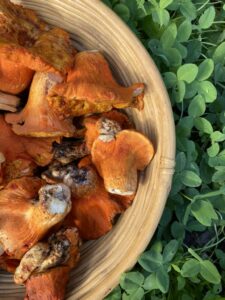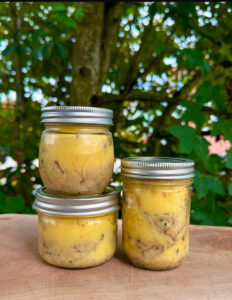![]()

The season for Lobster Mushrooms, or Hypomyces lactiflorum, is well underway here in BC, and should run into early November. Ask any chef, and they’ll gladly take them off your hands—but I rarely find a lobster mushroom enthusiast among the general public. Their firm texture and seafood-like flavour don’t substitute well in a typical mushroom dish. I too was not a fan for the first several years of my foraging career. But last year, everything changed.
For those who know me personally, you’re probably shocked to learn there was a mushroom I didn’t like. Don’t get me wrong—I enjoy finding every mushroom. Spotting the bright orange skin of a lobster mushroom peeking out from its earthen blanket is one of the best endorphin hits there is! But the excitement would quickly fade as the task of cleaning and deworming them threatened to consume my Sunday. Since I didn’t even like them and couldn’t give them away, finding one felt more like a problem than a prize. Historically, my solution had been to dehydrate them for some future occasion that never came. I was at a cross roads with two options: stop picking lobster mushrooms, or learn to like them. The first option just wasn’t going to cut it for me, so last year, when I found my first lobster mushroom of the season, I set aside a day to find the ultimate lobster mushroom recipe.

Lobster Mushroom Confit
First up was Lobster Mushroom Confit (pronounced con-fee), a recipe by chef Alan Bergo, perhaps better known as Forager Chef (foragerchef.com). If you don’t already know about him, he is an authority on cooking wild mushrooms, and for good reason. He has recipes tailored to most if not all edible wild mushrooms, and every one I’ve tried is delicious and easy to follow.
I had actually made this confit the year prior and froze it, but never got around to using it. So, I figured I’d better make sure I liked it before saddling myself with another two pounds of the stuff. Mac and cheese is a staple in our household, so we decided to make our take on the ever-trendy Lobster (Mushroom) Mac and Cheese. My husband made his standard recipe (no secrets there, Google or The Joy of Cooking will have you covered) but replaced the butter in the roux with a generous amount of the confit fat, straining out the mushrooms first and adding them back at the end to warm up.
I wish I had a more eventful story of the trials and tribulations we faced that day before finding the best recipe, but I don’t, because this Lobster Mushroom Mac and Cheese was an absolute knockout. The texture of the lobster mushrooms had completely transformed in the confit; they weren’t too crunchy but held their shape and colour, imparting the most wonderful flavour to the dish. If you find yourself with a few lobster mushrooms and an hour of prep time, this is the way to go, because it can be stored and used for a variety of dishes later. Another benefit of this recipe that cannot be overstated is that it works well for imperfect lobster mushrooms (as, *sigh*, they all seem to be) because you can cut around nasty bits and not worry too much about the shape and size of the resulting chunks.
Lobster Mushroom Chips
I had some extra time and a few pristine young mushrooms, so I decided to try making lobster mushroom chips. I used a vegetable peeler to make shavings, then effectively deep-fried them in a saucepan with an inch of olive oil heated on medium. They crisped up in about four minutes. I removed them with a slotted spoon, transferred them to a paper towel-lined plate, and sprinkled them with salt. We topped a chanterelle risotto with them; the experiment was another huge success. I’m not sure if this qualifies as a recipe, but definitely a technique, and one too good and too simple not to share. At this point, I was two for two and thought I’d better quit while I was ahead.
Dehydrated / Powdered Lobster Mushrooms
Of course, sometimes there’s no time to prepare or eat them at all, and I still stand by dehydrating them as a preferred preservation method, as their flavour intensifies and their texture is minimally affected. I have yet to try powdering them as a seasoning, but that’s on my list for this year. From there, I’m going to try making a Caesar cocktail rimmer and another of Bergo’s recipes, Dried Lobster Mushroom Rub.
For Best Results
If you’re a cook-by-feel kind of person, you may be less interested in recipes and more interested in the general guidelines. In my experience, which I’ve cross-referenced with local chefs, cookbooks, and friends, these are the notes to keep in mind:
- Lobster mushrooms pair well with thyme and other woody herbs;
- They should be cooked in a generous amount of oil/butter/fat;
- They need more cooking time than other mushrooms to soften, and likewise do not overcook easily;
- Their flavour is often described as a seafood-mushroom hybrid, so include them in dishes that benefit from both.
Afterword
I hope this article was informative and inspires you to get out into the woods, try new recipes, and make use of what nature provides. I made a few adaptations to Bergo’s confit—I used butter instead of animal fat, about a 1:1 ratio of lobster mushrooms to butter by weight, and swapped the cumin for a few black cardamom pods. I also simmered it on the stove with the lid off, rather than baking it in the oven, because I like being able to see my food and intervene if necessary when I’m making something new.
Alan Bergo generously allowed me to reference his recipes in this article. You can find them plus hundreds of others for free at foragerchef.com or read his book, The Forager Chef’s Book of Flora.
Fun Fact: Hypomyces lactiflorum is the species of fungus that parasitizes a white host mushroom, usually a type of Russula, resulting in what we know as the Lobster Mushroom.
Safety tip: Old lobster mushrooms (especially stinky, unappetizing ones) can have strong antimicrobial properties that may lead to upset stomachs, much like a course of antibiotics. However, the colourful outsides may be frozen for later use as dyestuffs. Never eat a wild mushroom unless you are 100% certain of its identification.
